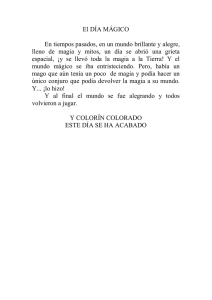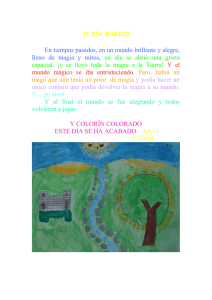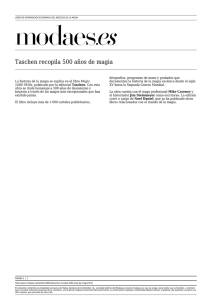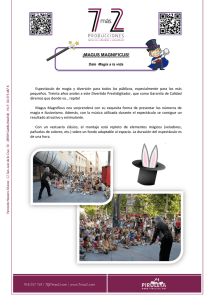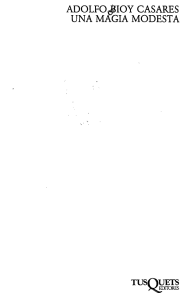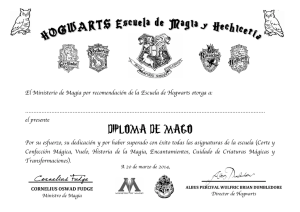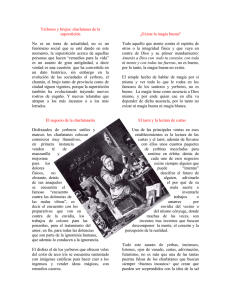1 DADES DE L`ASSIGNATURA Nom de l`assignatura Xamanisme i
Anuncio
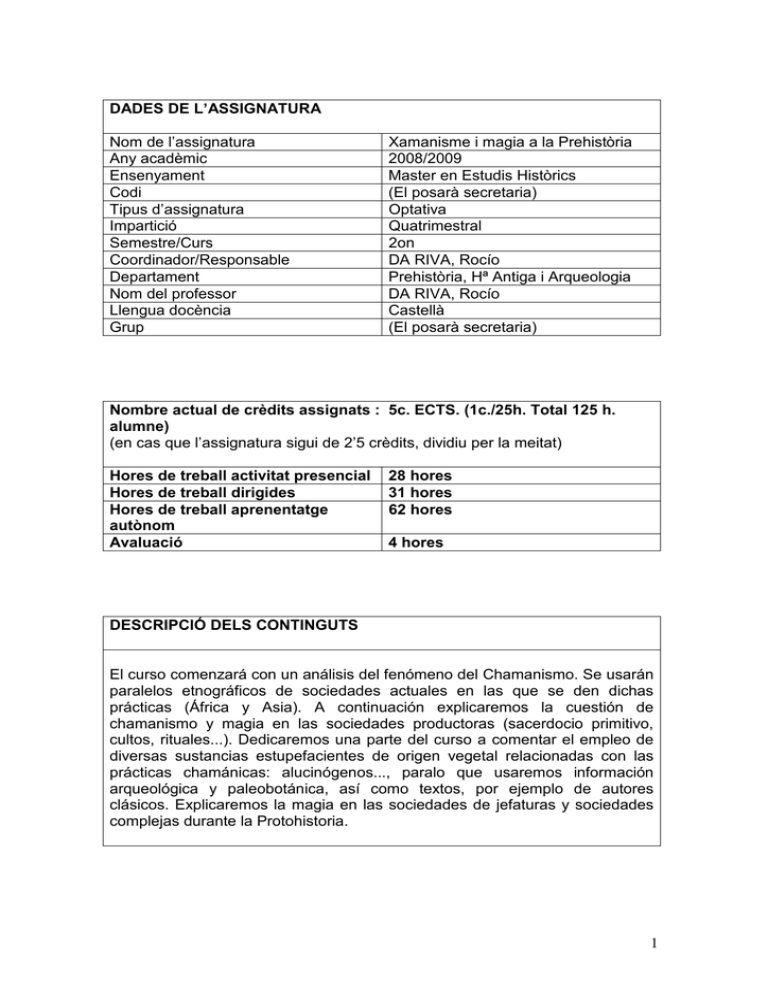
DADES DE L’ASSIGNATURA Nom de l’assignatura Any acadèmic Ensenyament Codi Tipus d’assignatura Impartició Semestre/Curs Coordinador/Responsable Departament Nom del professor Llengua docència Grup Xamanisme i magia a la Prehistòria 2008/2009 Master en Estudis Històrics (El posarà secretaria) Optativa Quatrimestral 2on DA RIVA, Rocío Prehistòria, Hª Antiga i Arqueologia DA RIVA, Rocío Castellà (El posarà secretaria) Nombre actual de crèdits assignats : 5c. ECTS. (1c./25h. Total 125 h. alumne) (en cas que l’assignatura sigui de 2’5 crèdits, dividiu per la meitat) Hores de treball activitat presencial Hores de treball dirigides Hores de treball aprenentatge autònom Avaluació 28 hores 31 hores 62 hores 4 hores DESCRIPCIÓ DELS CONTINGUTS El curso comenzará con un análisis del fenómeno del Chamanismo. Se usarán paralelos etnográficos de sociedades actuales en las que se den dichas prácticas (África y Asia). A continuación explicaremos la cuestión de chamanismo y magia en las sociedades productoras (sacerdocio primitivo, cultos, rituales...). Dedicaremos una parte del curso a comentar el empleo de diversas sustancias estupefacientes de origen vegetal relacionadas con las prácticas chamánicas: alucinógenos..., paralo que usaremos información arqueológica y paleobotánica, así como textos, por ejemplo de autores clásicos. Explicaremos la magia en las sociedades de jefaturas y sociedades complejas durante la Protohistoria. 1 CONEIXEMENTS QUE HA D’ASSOLIR L’ALUMNE 1. Objectius d’aprenentatge de l’assignatura Proporcionar una aproximación transversal sobre el fenónemo de la magia y la religión en las sociedades prehistóricas y protohistóricas. Aprender a interpretar fenónemos de culturas extintas a partir de datos de tipo arqueológico, paralelos etnográficos, y fuentes escritas tardías (orientales y clásicas). Conocimientos de tipo geográfico 2. Objectius d’adquisició d’habilitats i competències: Conocer bases de datos antropológicas (eHRAF), bases de datos bibliográficas. Manejarse con los diversos recursos virtuales y bibliográficos. Realizar reseñas, análisis, presentaciones en clase, debates etc. 3. Objectius d’aprenentatge d’actituds: Cuestionar teorías e interpretaciones. Analizar un fenómeno determinado desde diferentes marcos interpretativos. Saber defender puntos de vista diferentes. En general, todo aquello que se precisa para cursar esudios de master. MODEL D’AVALUACIÓ La evaluación será continuada, con la presentación de: 1. 4 trabajos a lo largo del curso: 2 reseñas bibliográficas y 2 pequeños trabajos de investigación (50%) 2. Asistencia a 2 exposiciones y 2 conferencias (20%), con comentarios y debates en clase 3. Presencialidad y participación en clase (10%) 4. Un breve trabajo de síntesis final (20%) como conclusión de la asignatura. 2 BLOCS TEMÀTICS Bloque 1 1. 2. 3. 4. 5. 6. 7. Chamanismo y magia: conceptos, interpretaciones Chamanas y chamanes Paralelos actuales: los Tsaatan de Hovsgol (Mongolia, Tuva), etc. Chamanismo y Magia Chamanismo y Medicina Chamanismo y Arte Debate de lecturas Bloque 2 1. Estados alterados de conciencia: neuropsicología y chamanismo 2. Sustancias alucinógenas y estupefacientes relacionadas con las prácticas chamánicas 3. Sustancias de origen vegetal (arqueobotánica) 4. Sustancias de origen animal (arqueozoología) 5. Documentos escritos sobre el uso de sustancias (textos orientales y autores clásicos) 6. Debate de lecturas Bloque 3 1. La Magia en la Prehistoria: el Paleolítico Superior 2. El registro arqueológico 3. Manifestaciones artísticas 4. Interpretaciones y debate de lecturas Bloque 4 1. La magia y la medicina en el Neolítico 2. Cultos y primeras manifestaciones de magia 3. Mundo ritual y funerario 4. Debate de lecturas Bloque 5 1. La magia en las sociedades de jefaturas: Bronce y Hierro 2. La magia en el Mediterráneo Oriental: fuentes arqueológicas 3. Listas lexicales sobre magia, medicina y sustancias 4. Debate de lecturas 3 MATERIALS DE SUPORT A LA DOCÈNCIA Varios powerpoints que se colgarán en el Moodle sobre los diferentes temas de la asignatura - Uso de eHRAF: base de datos antropológica - Uso de JSTOR y otras bases de datos: ABZU-Etana, OI Lib, etc. - DVD: documentales - CD: Música chamánica - Algunos enlaces: http://mongoluls.net/mongolian-religion/monrelihis.shtml http://www.st-andrews.ac.uk/~www_sd/magic.html http://www.indigogroup.co.uk/edge/otzi.htm http://www.indigogroup.co.uk/edge/otzi.htm http://www.uniheidelberg.de/subject/hd/fak7/hist/o1/logs/sophia/log.started940311/mail37.html https://eprints.soas.ac.uk/3313/ http://www.lib.umich.edu/pap/exhibits/magic/intro.html http://fathom.lib.uchicago.edu/1/777777122299/ http://www.britishmuseum.org/explore/highlights/highlight_objects/aoa/s/sha mans_drum.aspx http://www.st-andrews.ac.uk/~www_sd/hekhalot_shamanism_art.html - METODOLOGIA I ORGANITZACIÓ DE L’ASSIGNATURA Las clases serán presenciales, pues se trata de evaluación continuada. Se explicarán los contenidos en clase, usando mucho material visual y de audio, esperando participación y feedback por parte del alumno: debates de lecturas Se encargarán salidas: asistencia a conferencias y exposiciones, de las que el alumno deberá realizar una pequeña reseña o comentario crítico. 4 BIBLIOGRAFIA La bibliografía se irá adaptando a lo largo del curso. Se entregarán elencos bibliográficos en PDF que se pondrán en el Moodle, así como diversos materiales virtuales sobre el tema. Como introducción: Revistas (víd. “Shamanism” en JSTOR; Jones (2004), etc.) Shaman: Journal of the International Society for Shamanistic Research, Vol.1, no. 1 (1993)- . Szeged, Hungary: Molnar & Kelemen Oriental Publishers. Shamanic Applications Review: A Journal of Religious Resources in Psychotherapy, Vol. 1, no. 1 (1995)- . Niles, MI: Foundation for Religious Resources in Psychotherapy. Shaman’s Drum: A Journal of Experiential Shamanism and Spiritual Healing, No. 1 (1985)- . Williams, OR: Cross-Cultural Shamanism Network. Obras de referencia: Lyon, William S. 1996. Encyclopedia of Native American Healing. Santa Barbara, CA: ABC-CLIO. Lyon, William S. 1998. Encyclopedia of Native American Shamanism: Sacred Ceremonies of North America. Santa Barbara, CA: ABC-CLIO. Osterreich, Shelley Anne, comp. 1998. Native North American Shamanism: An Annotated Bibliography. Bibliographies and Indexes in American History, Number 38. Westport, CT: Greenwood Press. Monografías Backman, Louise and Ake Hultkrantz. 1978. Studies in Lapp Shamanism. Acta Universitatis Stockholmiensis. Stockholm Studies in Comparative Religion, 16. Stockholm: Almqvist & Wiksell International. Balzer, Marjorie Mandelstam, ed. 1990. Shamanism: Soviet Studies of Traditional Religion in Siberia and Central Asia. Armonk, NY, M. E. Sharpe. Bibliotheca Shamanistica. Budapest: Akademiai Kiado. A series of books published by the International Society for Shamanistic Research on the advances in the studies of shamanism. Vol. 1: Kim, Tae-gon and Mihaly Hoppal, eds. 1995. Shamanism in Performing Arts. Vol. 2: Dioszegi, Vilmos and Mihaly Hoppal, eds. 1996. Shamanism in 5 Siberia. Vol. 3: Dioszegi, Vilmos, ed. 1996. Folk Beliefs and Shamanistic Traditions in Siberia. Vol. 4: Musi, Carla Corradi. 1997. Shamanism from East to West. Vol. 5: Kister, Daniel A. 1997. Korean Shamanist Ritual: Symbols and Dramas of Transformation. Vol. 6: Hoppal, Mihaly, ed. 1998. Shamanism: Selected Writings of Vilmos Dioszegi. Vol. 7: Hogarth, Hyun-key Kim. 1998. Kut: Happiness through Reciprocity. Vol. 8: Yamada, Takako. 1999. An Anthropology of Animism and Shamanism. Black Elk, Nicholas. 2000. Black Elk Speaks: Being the Life Story of a Holy Man of the Oglala Sioux. As told through John G. Neihardt (Flaming Rainbow). 21st century ed. Lincoln: University of Nebraska Press. Black Elk, Nicholas. 1953. The Sacred Pipe: Black Elk’s Account of the Seven Rites of the Oglala Sioux. Recorded and edited by Joseph Epes Brown. Norman: University of Oklahoma Press. Black Elk, Wallace H. and William S. Lyon. 1990. Black Elk: the Sacred Ways of a Lakota. New York: Harper & Row. Czaplicka, Marie Antoinette. 1914. Aboriginal Siberia: A Study in Social Anthropology. Oxford: Clarendon Press. Dioszegi, Vilmos. 1968. Tracing Shamans in Siberia. The Story of an Ethnographical Research Expedition. Translated from the Hungarian by Aita Rajkay Babo. Oosterhout, The Netherlands: Anthropological Publications. Drury, Nevill. 1996. Shamanism. The Element Library. Shaftesbury, Dorset: Element. Eliade, Mircea. 1964. Shamanism: Archaic Techniques of Ecstacy. Translated from the French by Willard R. Trask. (Revised and enlarged from the original French edition, Le Charmanisme et les techniques archaiques de l’extase, 1951). New York: Bollingen Foundation. Flaherty, Gloria. 1992. Shamanism and the Eighteenth Century. Princeton, N.J.; Princeton University Press. Halifax, Joan. 1979. Shamanic Voices: A Survey of Visionary Narratives. New 6 York: Dutton. Halifax, Joan. 1982. Shaman, the Wounded Healer. New York: Crossroad. Halifax, Joan. 1993. The Fruitful Darkness: Reconnecting with the Body of the Earth. San Francisco: HarperSanFrancisco. Harner, Michael J., ed. 1973. Hallucinogens and Shamanism. New York: Oxford University Press. Harner, Michael J. 1990. The Way of the Shaman. 3rd ed. San Francisco: Harper & Row. Heinze, Ruth-Inge, ed. 1984- . Proceedings of the…International Conference on the Study of Shamanism and Alternate Modes of Healing. Berkeley, CA: Independent Scholars of Asia. Heinze, Ruth-Inge. 1991. Shamans of the 20th Century. With contributions by Charlotte Berney, Etzel Cardena, Chungmoo Choi, Sarah Dubin-Vaughn, Stanley Krippner, and Alok Saklani. New York: Irvington. Hoppal, Mihaly and Otto von Sadovszky, eds. 1989. Shamanism: Past and Present. International Society for Trans-Oceanic Research, Parts 1-2. Budapest: Ethnographic Institute, Hungarian Academy of Sciences. Hutton, Ronald. 2001. Shamans: Siberian Spirituality and the Western Imagination. London: Hambledon and London. Kalweit, Holger. 1988. Dreamtime & Inner Space: the World of the Shaman. Translated from the German by Werner Wunsche. Boston: Shambhala. Kalweit, Holger. 1992. Shamans, Healers, and Medicine Men. Translated from the German by Michael H. Kohn. Boston: Shambhala. Michael, Henry N., ed. Studies in Siberian Shamanism. Anthropology of the North: Translations from Russian Sources, No. 4. Toronto: Published for the Arctic Institute of North America by University of Toronto Press. Narby, Jeremy and Francis Huxley, eds. 2001. Shamans through Time: 500 Years on the Path to Knowledge. New York: J.P. Tarcher/Putnam. Nicholson, Shirley, comp. 1987. Shamanism: An Expanded View of Reality. Wheaton, IL: Theosophical Pub. House. Plotkin, Mark J. 1993. Tales of a Shaman’s Apprentice: An Ethnobotanist Searches for New Medicines in the Amazon Rain Forest. New York: Viking. Price, Neil S., ed. 2001. The Archaeology of Shamanism. London and New York: Routledge. 7 Ripinsky-Naxon, Michael. 1993. The Nature of Shamanism: Substance and Function of a Religious Metaphor. Albany, NY: State University of New York Press. Rogers, Spencer L. 1982. The Shaman, His Symbols and His Healing Power. Springfield, IL: Charles C. Thomas. Siikala, Anna-Leena. 1978. The Rite Technique of the Siberian Shaman. FF Communications, No. 220. Helsinki: Suomalainen tiedeakatemia. Siikala, Anna-Leena and Mihaly Hoppal. 1998. Studies on Shamanism. Ethnologica Uralica, 2. Helsinki: Finnish Anthropological Society. Thorpe, S. A. 1993. Shamans, Medicine Men and Traditional Healers: A Comparative Study of Shamanism in Siberian Asia, Southern Africa and North America. Pretoria: University of South Africa. Vitebsky, Piers. 1995. The Shaman. 1st American ed. Living Wisdom. Boston: Little, Brown. Walker, Deward E., ed. 1989. Witchcraft and Sorcery of the American Native Peoples. Moscow, Idaho: University of Idaho Press. 8
